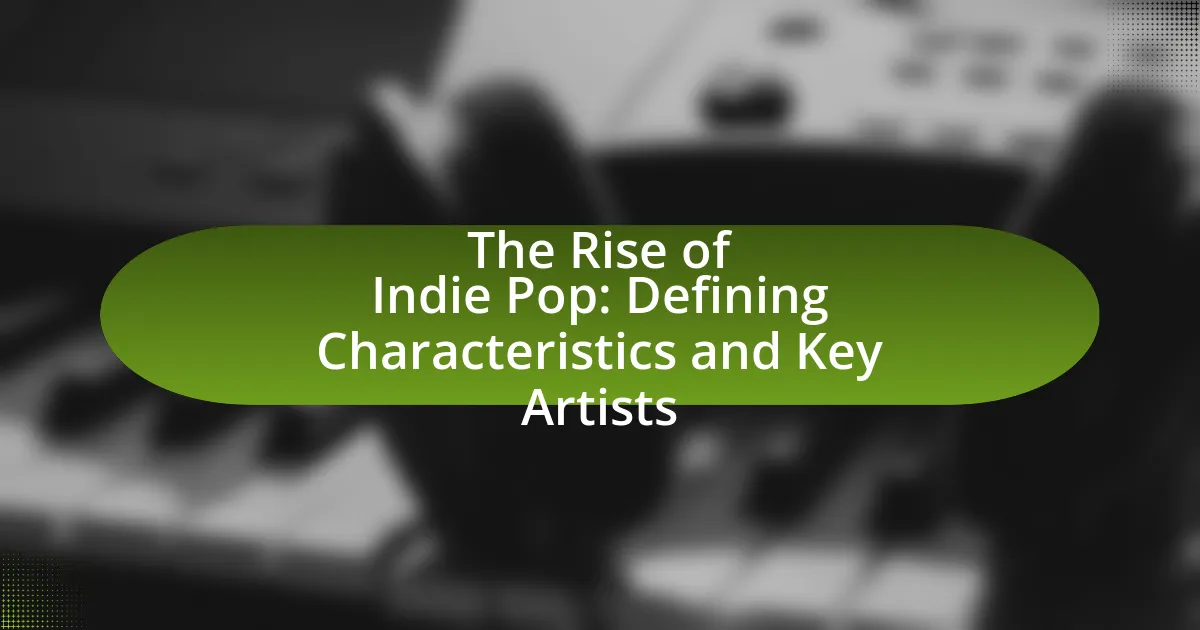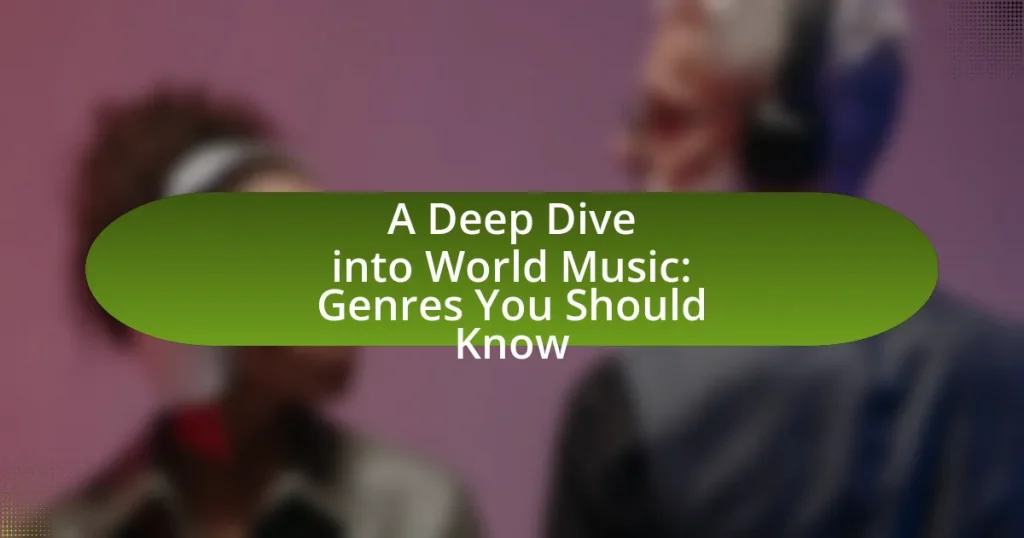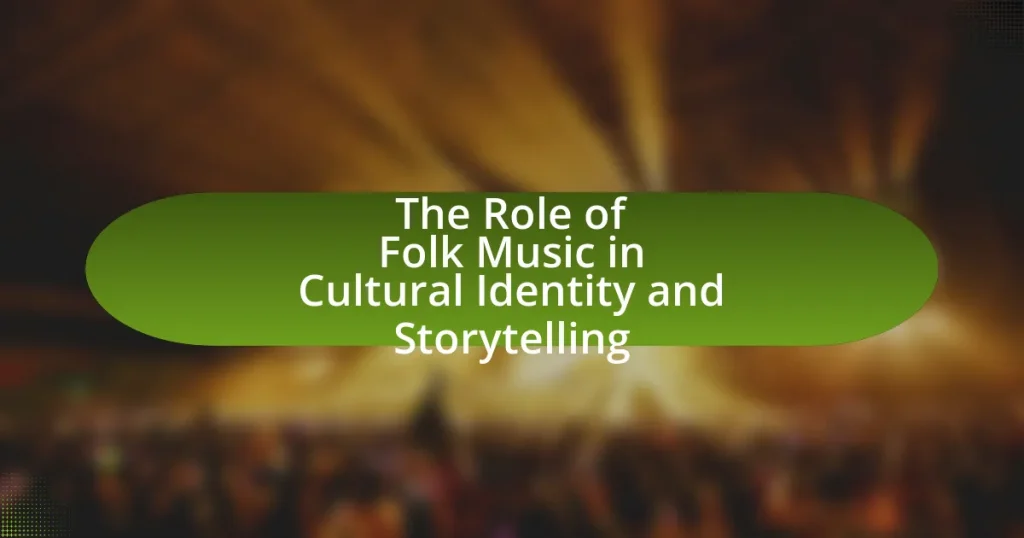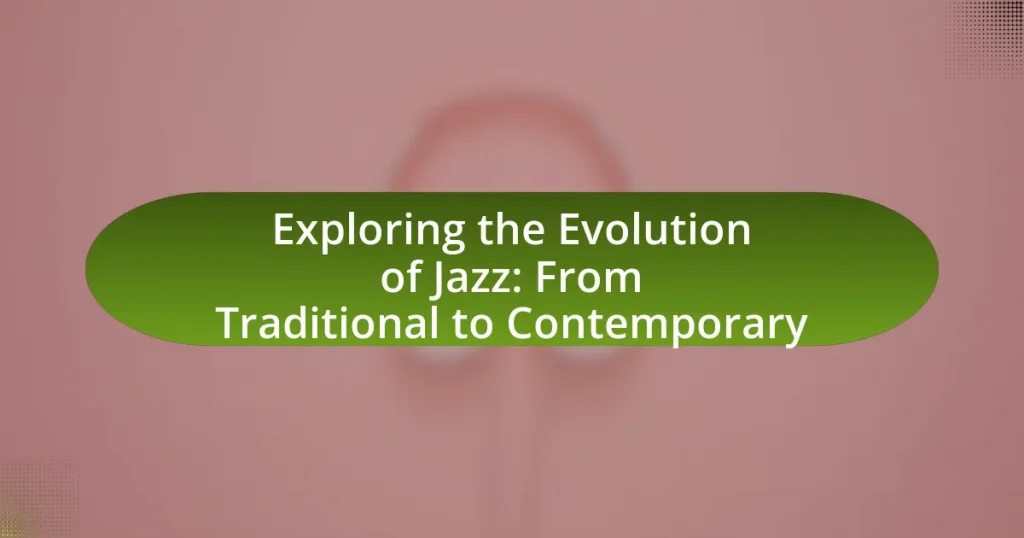Indie pop is a music genre that emerged in the late 1970s and early 1980s, characterized by independent production and melodic, introspective songwriting. This article explores the defining characteristics of indie pop, including its DIY ethos, diverse instrumentation, and focus on artistic expression over commercial success. It examines the historical factors that contributed to the genre’s rise, key artists who shaped its sound, and contemporary musicians making significant contributions today. Additionally, the article discusses how indie pop influences modern music trends and offers insights for aspiring artists on navigating the current music landscape.
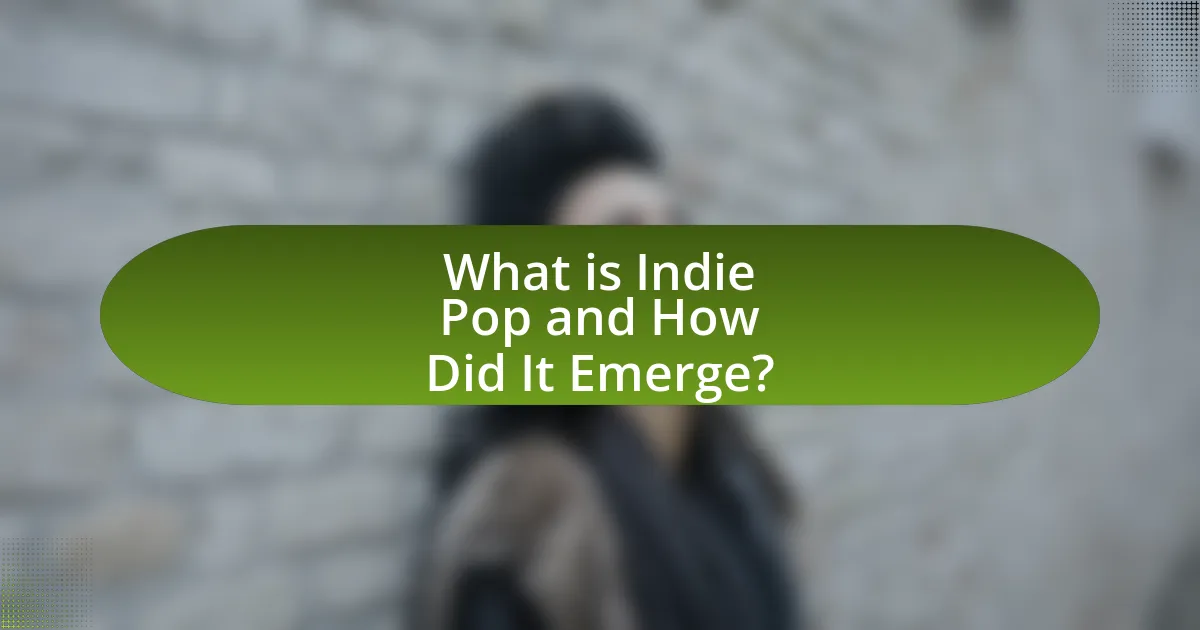
What is Indie Pop and How Did It Emerge?
Indie pop is a genre of music characterized by its independent production and a focus on melodic, often introspective songwriting. It emerged in the late 1970s and early 1980s as a response to the mainstream music industry, with artists seeking creative freedom outside of major record labels. The term “indie” reflects the independent nature of the artists and their music, which often features a DIY ethos. Key influences include punk rock and post-punk bands, which emphasized authenticity and artistic expression. Notable early indie pop bands include The Smiths and The Vaselines, who helped shape the sound and aesthetic of the genre. The rise of indie pop was further propelled by the advent of the internet in the 1990s, allowing for greater distribution and discovery of independent music.
What are the defining characteristics of Indie Pop?
Indie Pop is characterized by its melodic sound, DIY ethos, and a focus on artistic expression over commercial success. This genre often features catchy hooks, diverse instrumentation, and a blend of various musical influences, including rock, folk, and electronic elements. The DIY ethos is evident in the way many Indie Pop artists produce and distribute their music independently, often through small labels or self-released platforms. Additionally, lyrical themes in Indie Pop frequently explore personal and introspective subjects, setting it apart from mainstream pop music. The genre gained prominence in the 1980s and 1990s, with bands like The Smiths and Belle and Sebastian exemplifying these characteristics, contributing to its lasting influence in contemporary music.
How does Indie Pop differ from mainstream pop music?
Indie Pop differs from mainstream pop music primarily in its production approach and artistic independence. Indie Pop artists typically operate outside of major record labels, allowing for greater creative freedom and experimentation in their sound, often resulting in a more diverse range of musical styles and lyrical themes. In contrast, mainstream pop music is usually produced with commercial viability in mind, often adhering to formulaic structures and trends to maximize radio play and sales. This distinction is evident in the way Indie Pop embraces lo-fi production techniques and unconventional song structures, while mainstream pop often prioritizes polished production and catchy hooks designed for mass appeal.
What themes and styles are commonly found in Indie Pop?
Indie Pop commonly features themes of introspection, individuality, and emotional vulnerability, often expressed through relatable lyrics and melodic hooks. The style is characterized by a blend of pop sensibilities with alternative and experimental elements, utilizing unconventional song structures and instrumentation. Artists in this genre frequently draw inspiration from personal experiences, relationships, and social commentary, which resonates with listeners seeking authenticity. The genre’s roots can be traced back to the 1980s, with bands like The Smiths and R.E.M. paving the way for contemporary acts such as Vampire Weekend and Florence + The Machine, who continue to explore these themes while pushing stylistic boundaries.
What historical factors contributed to the rise of Indie Pop?
The rise of Indie Pop was significantly influenced by the emergence of independent record labels in the 1980s and 1990s, which provided artists with the opportunity to produce and distribute music outside of the mainstream music industry. This shift allowed for greater creative freedom and diversity in sound, as artists were no longer bound by commercial pressures. Additionally, the advent of digital technology and the internet in the late 1990s facilitated the distribution and promotion of Indie Pop, enabling artists to reach wider audiences without the need for major label backing. The DIY ethos prevalent in the punk rock movement also played a crucial role, inspiring musicians to create and share their work independently. These factors collectively contributed to the establishment and growth of the Indie Pop genre.
How did the music industry changes in the 1990s influence Indie Pop?
The changes in the music industry during the 1990s significantly influenced Indie Pop by facilitating greater access to production and distribution for independent artists. The rise of alternative music labels and the decline of major label dominance allowed Indie Pop musicians to produce and promote their work without the constraints of traditional record contracts. This shift was exemplified by the success of bands like Nirvana, which opened doors for smaller acts, leading to a flourishing of diverse sounds and styles within the Indie Pop genre. Additionally, the advent of digital technology and the internet in the late 1990s enabled artists to reach wider audiences directly, further democratizing the music landscape and allowing Indie Pop to thrive.
What role did technology play in the growth of Indie Pop?
Technology significantly facilitated the growth of Indie Pop by enabling artists to produce, distribute, and promote their music independently. The advent of affordable recording software and digital audio workstations allowed musicians to create high-quality recordings at home, reducing reliance on traditional record labels. Additionally, platforms like Bandcamp and SoundCloud provided accessible avenues for distribution, allowing artists to reach global audiences without significant financial investment. The rise of social media further amplified this effect, enabling artists to connect directly with fans and build communities around their music. These technological advancements collectively democratized the music industry, fostering a diverse range of voices within the Indie Pop genre.

Who are the Key Artists in the Indie Pop Scene?
Key artists in the indie pop scene include Tame Impala, Phoebe Bridgers, and Vampire Weekend. Tame Impala, led by Kevin Parker, is known for its psychedelic sound and critically acclaimed albums like “Currents.” Phoebe Bridgers gained recognition for her introspective lyrics and collaborations, particularly with her album “Punisher.” Vampire Weekend, formed in 2006, has been influential with their eclectic style and hits like “A-Punk.” These artists exemplify the diversity and innovation within the indie pop genre, contributing significantly to its popularity and evolution.
Which artists are considered pioneers of Indie Pop?
The artists considered pioneers of Indie Pop include The Smiths, R.E.M., and Belle and Sebastian. The Smiths, active in the 1980s, are known for their jangly guitar sound and introspective lyrics, which influenced many Indie Pop bands. R.E.M., also from the 1980s, blended rock with folk elements, paving the way for alternative music. Belle and Sebastian emerged in the 1990s, characterized by their melodic tunes and storytelling lyrics, further defining the genre. These artists laid the groundwork for the Indie Pop movement, shaping its sound and aesthetic.
What impact did these pioneers have on the genre?
These pioneers significantly shaped the indie pop genre by introducing innovative sounds and DIY ethics that emphasized artistic freedom. Their influence is evident in the way they blended various musical styles, creating a diverse sound palette that expanded the genre’s boundaries. For instance, artists like Belle and Sebastian and The Magnetic Fields incorporated elements of folk, rock, and electronic music, which encouraged subsequent indie pop musicians to experiment with their own sound. Additionally, their commitment to independent production and distribution paved the way for a thriving underground music scene, allowing new artists to emerge without the constraints of major label expectations. This shift not only democratized music production but also fostered a sense of community among indie artists, further solidifying the genre’s identity.
How did their music shape the sound of Indie Pop?
Their music significantly shaped the sound of Indie Pop by introducing a blend of melodic hooks, lo-fi production, and introspective lyrics. Key artists like The Smiths and Belle and Sebastian emphasized jangly guitars and heartfelt storytelling, which became foundational elements of the genre. The incorporation of diverse influences, such as folk and punk, allowed Indie Pop to evolve, creating a distinct sound characterized by both accessibility and artistic authenticity. This evolution is evidenced by the rise of bands in the 2000s, such as Vampire Weekend and Arctic Monkeys, who drew inspiration from these earlier artists, further solidifying the genre’s identity and expanding its reach in popular music.
What are some contemporary Indie Pop artists making waves today?
Contemporary Indie Pop artists making waves today include Phoebe Bridgers, Clairo, and Snail Mail. Phoebe Bridgers has gained significant recognition for her introspective lyrics and unique sound, highlighted by her critically acclaimed album “Punisher,” which was nominated for multiple Grammy Awards in 2021. Clairo, known for her bedroom pop aesthetic, achieved viral success with her song “Pretty Girl” and continues to influence the genre with her debut album “Immunity.” Snail Mail, led by Lindsey Jordan, has garnered attention for her emotionally resonant songwriting, particularly with her debut album “Lush,” which received widespread acclaim and solidified her place in the Indie Pop scene.
How do these contemporary artists reflect the evolution of Indie Pop?
Contemporary artists reflect the evolution of Indie Pop by incorporating diverse musical influences, innovative production techniques, and lyrical themes that resonate with modern audiences. For instance, artists like Phoebe Bridgers and Tame Impala blend elements of rock, electronic, and folk, showcasing the genre’s adaptability. Additionally, the rise of digital platforms has enabled these artists to reach wider audiences, further diversifying the sound and style of Indie Pop. This evolution is evidenced by the genre’s increasing presence on mainstream charts, with tracks from artists like Billie Eilish achieving significant commercial success while maintaining an indie aesthetic.
What unique contributions are they making to the genre?
Indie pop artists are making unique contributions to the genre by blending diverse musical influences and prioritizing authenticity over commercial appeal. This genre often features unconventional song structures, introspective lyrics, and a DIY ethos that encourages artistic freedom. For example, artists like Sufjan Stevens incorporate orchestral elements and folk influences, while bands like Vampire Weekend fuse world music with pop sensibilities, showcasing a wide range of cultural inspirations. These contributions not only expand the sonic palette of indie pop but also challenge mainstream music norms, fostering a more inclusive and innovative musical landscape.
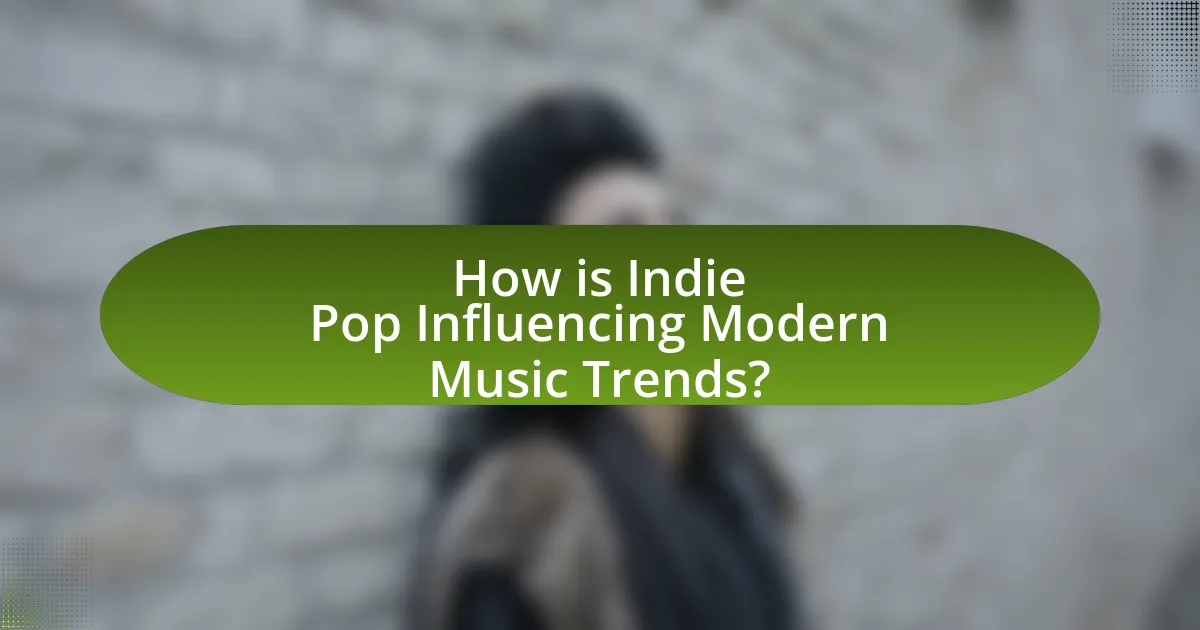
How is Indie Pop Influencing Modern Music Trends?
Indie pop is significantly influencing modern music trends by promoting a DIY ethos and blending diverse genres, which encourages innovation and authenticity among artists. This genre’s emphasis on personal storytelling and emotional depth resonates with listeners, leading to a rise in popularity for artists who prioritize individuality over commercial appeal. For instance, the success of artists like Phoebe Bridgers and Tame Impala showcases how indie pop’s experimental sounds and introspective lyrics have permeated mainstream music, shaping the sonic landscape of contemporary pop and rock. Additionally, platforms like Bandcamp and SoundCloud have enabled indie artists to reach wider audiences, further solidifying indie pop’s impact on the music industry.
What trends in music are being shaped by Indie Pop?
Indie Pop is shaping several key trends in music, including the rise of DIY production, genre blending, and a focus on lyrical authenticity. The DIY production trend is evident as many Indie Pop artists utilize home studios and affordable technology to create music independently, leading to a more diverse sound palette. Genre blending is also prominent, with Indie Pop artists frequently incorporating elements from rock, electronic, and folk, resulting in innovative and eclectic musical styles. Additionally, the emphasis on lyrical authenticity resonates with listeners, as artists often share personal stories and experiences, fostering a deeper emotional connection. This trend is supported by the success of artists like Phoebe Bridgers and Tame Impala, who exemplify these characteristics and have gained significant popularity in the mainstream music scene.
How is Indie Pop impacting other genres?
Indie Pop is significantly impacting other genres by introducing diverse sounds, innovative production techniques, and a DIY ethos that encourages artistic freedom. This influence is evident as mainstream pop, rock, and electronic music increasingly incorporate elements characteristic of Indie Pop, such as lo-fi aesthetics, unconventional song structures, and introspective lyrics. For instance, artists like Billie Eilish and Tame Impala have successfully blended Indie Pop elements with pop and psychedelic rock, respectively, leading to chart-topping hits that reflect this cross-genre integration. Additionally, the rise of streaming platforms has facilitated the dissemination of Indie Pop, allowing its stylistic traits to permeate various musical landscapes, thus reshaping the overall sound of contemporary music.
What collaborations are emerging between Indie Pop artists and mainstream musicians?
Emerging collaborations between Indie Pop artists and mainstream musicians include notable partnerships such as the collaboration between Phoebe Bridgers and Kid Cudi on the track “Moon Song,” and the work of Clairo with artists like Dua Lipa on remixes. These collaborations highlight a trend where Indie Pop artists are increasingly sought after by mainstream musicians for their unique sound and authenticity. The blending of styles not only expands the reach of Indie Pop but also introduces mainstream audiences to diverse musical influences, as seen in the growing number of cross-genre projects and features in recent years.
What can aspiring Indie Pop artists learn from the genre’s evolution?
Aspiring Indie Pop artists can learn the importance of authenticity and innovation from the genre’s evolution. The genre has historically thrived on a DIY ethos, allowing artists to express personal narratives and unique sounds without the constraints of mainstream commercial pressures. For instance, the rise of bands like Neutral Milk Hotel and artists such as Sufjan Stevens in the 1990s and early 2000s showcased how personal storytelling and experimental sounds could resonate with audiences, leading to critical acclaim and a dedicated fanbase. This evolution emphasizes that Indie Pop artists should prioritize their individual artistic vision and embrace experimentation to carve out their niche in a competitive music landscape.
What best practices should new artists consider when entering the Indie Pop scene?
New artists entering the Indie Pop scene should prioritize authenticity in their music and branding. Authenticity resonates with audiences, as evidenced by the success of artists like Billie Eilish and Tame Impala, who have built strong fan bases through genuine expression. Additionally, new artists should engage actively on social media platforms to cultivate a community and share their journey, as studies show that 70% of music discovery occurs through social media. Collaborating with other indie artists can also enhance visibility and create unique sounds, as seen in the collaborative efforts of artists within the genre. Finally, investing in quality production and live performances is crucial, as high production values can significantly impact listener retention and engagement.
How can artists effectively promote their music in today’s landscape?
Artists can effectively promote their music in today’s landscape by leveraging social media platforms, engaging with their audience, and utilizing streaming services. Social media allows artists to reach a global audience, with platforms like Instagram and TikTok enabling them to share snippets of their music and connect personally with fans. Engaging with the audience through live streams, Q&A sessions, and behind-the-scenes content fosters a sense of community and loyalty. Additionally, utilizing streaming services like Spotify and Apple Music, which have algorithms that promote new music to listeners, can significantly increase an artist’s visibility. According to a 2021 report by the International Federation of the Phonographic Industry, streaming accounted for 62% of global recorded music revenue, highlighting its importance in music promotion.
